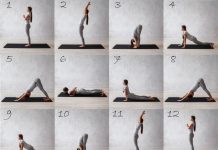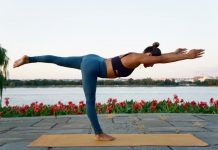The term ‘meditation’ often evokes an image of a person sitting cross legged or in a yogic posture and trying to elevate the sense of consciousness through a series of breathing exercises and cognitive focus. Many people use short verses or couplets, known as gathas, to help them concentrate. Some people close their eyes while some don’t. Many people have their meditative hideouts while some are focused enough to meditate anywhere.
Walking meditation is slightly different from the traditional form of meditation. It combines exercise with the same level of control of one’s consciousness. It is not fair to compare both types of meditation as they are not a substitute for one another. Walking meditation can be really helpful for those who want to indulge in some activity or motion. It could be just to flex the muscles, to stretch the body and to aid blood circulation or to just burn some calories.
The Purpose of Walking Meditation
Walking meditation is a way to disassociate yourself from the hustle and bustle of life. You should be able to pause, slow down and isolate your body as well as your mind from the demands of everyday life. Your body and mind should live in the present moment, being mindful of its being and indulging in brisk walking while enhancing the level of consciousness. You could start normal meditation and then switch to walking meditation if you want.
Getting Started for Walking Meditation
You need a timeframe and you need a place to walk. It could be the nearest park, a jogging trail, a path circling your neighborhood, the pavement up and down the street leading to and from your house or the beach. It could also be your lawn or backyard. The place you choose must allow you to take at least fifteen paces. Do not choose uphill or downhill roads. Choose plains or a flat terrain.
You must prepare your body to embark on a brisk walk. Stretch your body, including your core muscles, arms and legs, hip flexors and the back. Work on the neck with some horizontally sideways motion, then upward and downward stretches. Keep three to five minutes aside for all the stretches. This will get the blood flowing to various parts of the body and your body will be flexed to walk longer.
Correct your walking posture. Not many people have an impeccable posture while walking, or sitting and running for that matter. Your spine should be absolutely straight. You should not lean forward or backward. Your back shouldn’t slouch. You should not stress too much on your knees or ankle, feet or any specific part of your leg. You should not exert too much pressure on your waist or thighs either.
People walk differently but ideally the whole body should be a finely balanced and perfectly aligned system. Your walk should be smooth, without any bumps and without your body leaning heavily in any direction. You should not feel your bodyweight in any specific part of your body. This will be difficult for obese and overweight people but targeting the bodyweight is also a part of walking meditation.
Embark on the Walk
You should have a predefined path, preset number of steps or an end point in sight. Do not start walking on an endless trail. Do not count steps if that distracts you or interferes with your calming the mind. Do not have a predefined path if there are too many people who would invariably come in your way. Choose an end point and just get there with easy steps. Do not leap and do not take baby steps. Take gentle and comfortable strides without affecting your posture.
As you take these steps, let us say twenty of them, breathe normally. Breathe in normally and breathe out normally as you would do while walking. Don’t hold your breath and don’t take deep breaths. Once you end one set of, say twenty steps, and reach your end point, you should take a deep breath. This deep breath can be as long as you want, like or need. Finish breathing and retrace your steps back to where you started.
You can go on forward if you are at a large park or long trail. Also, you can go fifty steps before you stop. There is no rule that limits these aspects. But once you finish repeating the first set of, say twenty or fifty steps, in the same way or opposite direction, breathe again. These pauses and deep breaths are very important. These will let you gain control of your body and mind. This will heighten your senses and calm you.
Repeat the whole process for ten minutes or so the first day. You can go on doing this for even an hour if you like. But don’t have steep targets as you get started with walking meditation. You should be constant with your pace. The body needs to get into a rhythm for effective walking meditation. You should not get distracted by objects around you and even if people are staring at you, let them be and don’t feel uncomfortable.
Be your natural self, move your hands and arms as you would do naturally and do not be overly conscious that you need to attain a higher sense of consciousness. Walking meditation or meditation is not about a conscious attempt to enhance consciousness. It comes naturally once you are in that zone, aloof from the whole world, confined within your senses and at ease with your body, conscious mind and the subconscious.
Finding Your Own Approach
Some people breathe in and out with each subsequent step they take. Some people breathe in and out for a set of three to four steps. Some people keep breathing in and out as they keep walking, accounting for about five rounds of inhaling and exhaling for fifty steps. There is no rule or standard here. Whatever works for you and makes you comfortable is good. You shouldn’t feel out of breath and you should not feel compelled to breathe in at a specific time when you don’t need to inhale.
Finding the ideal pace at which you would walk, how quickly you should breathe and how long you would go before you pause to take those deep breaths, everything depends on what you are comfortable with. You can never meditate successfully if you are not comfortable with yourself. Walking meditation is not an exception to this truth.
Do not hold your breath at any stage, do not let your mind astray with thoughts or distractions around you, do not let any chore or liability bother you and certainly don’t ponder over anything that is troubling you. Instead, feel the walk. Feel how you are placing your feet, including the ankle and toes on the ground, how your legs are stretching as you take your steps, how your hip flexor is balancing your body and how your core muscles are stabilizing your posture as you move ahead.
Once you start experiencing such senses, let your mind focus on your persistent feelings. These feelings can be of joy, sorrow, pain, pleasure or discomfort. Any feeling is a gateway to greater consciousness but only after you are in that rhythm where your body and mind are in harmonious sync.
47 Most Famous Motivational Quotes of All-Time
49 Greatest Love Quotes
37 Inspirational Quotes that Will Change Your Life






























